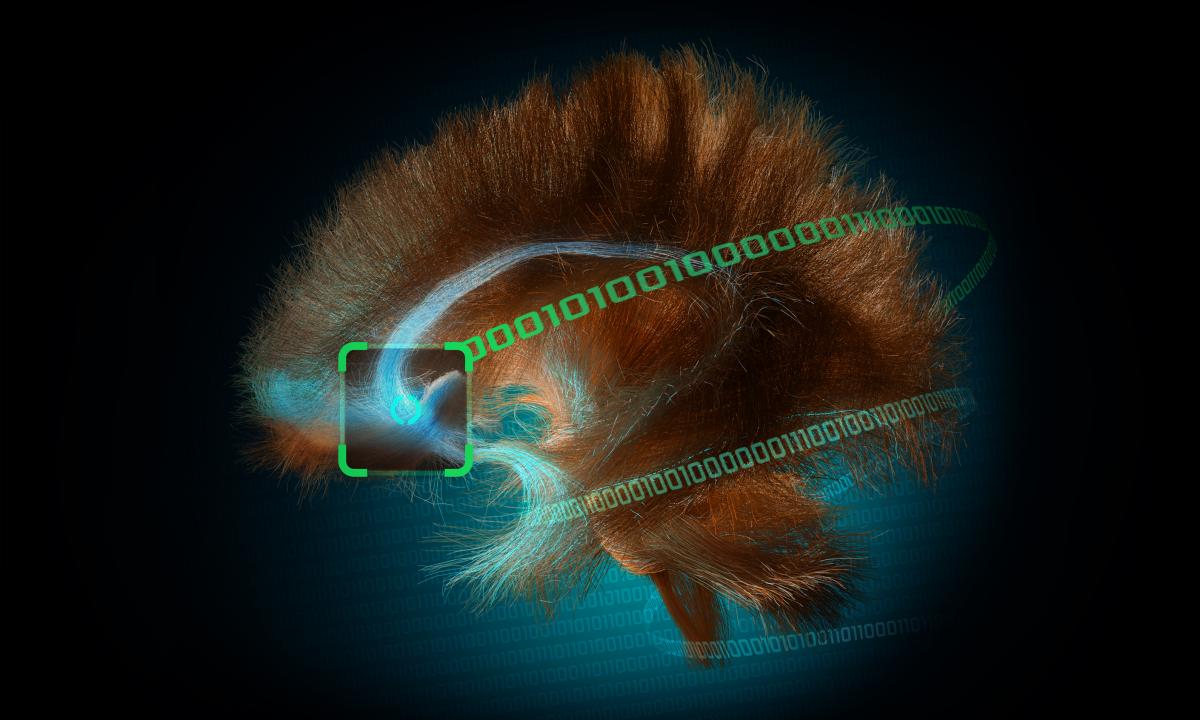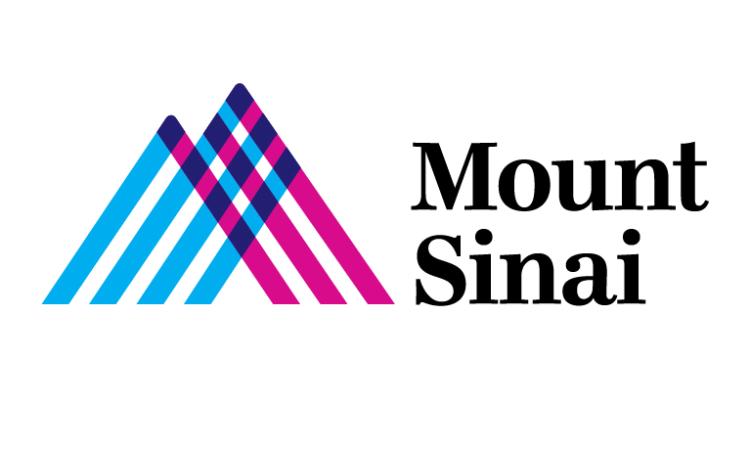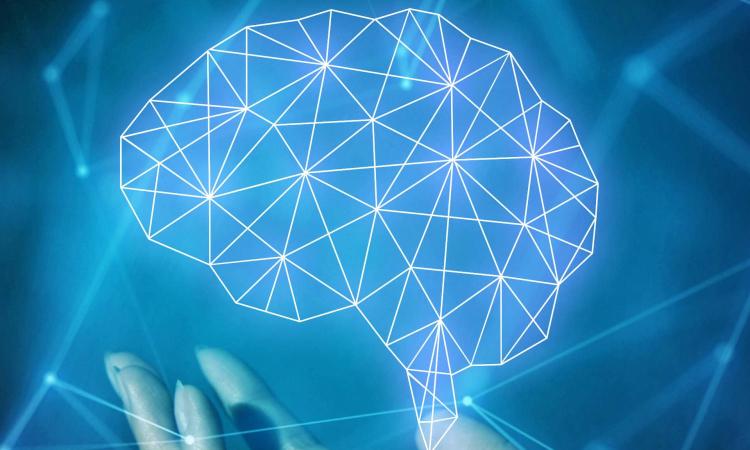Harnessing the power of explainable AI, researchers have unveiled the first insights into the complex workings of deep brain stimulation therapy for severe depression.

An artist's rendering of the white matter tracts in the brain of a patient in the study by Georgia Tech, Mount Sinai, and Emory University researchers. The rendering was created using a 3D model created with data from a special type of MRI. The highlighted area is the region targeted in deep brain stimulation therapy for treatment-resistant depression. Recordings of brain activity during treatment paired with new explainable AI tools can provide objective data about recovery to physicians.
A team of clinicians, engineers, and neuroscientists has made a groundbreaking discovery in the field of treatment-resistant depression. By analyzing the brain activity of patients undergoing deep brain stimulation (DBS), the researchers identified a unique pattern in brain activity that reflects the recovery process in patients with treatment-resistant depression. This pattern, known as a biomarker, serves as a measurable indicator of disease recovery and represents a significant advance in treatment for the most severe and untreatable forms of depression.
The team’s findings, published in the journal Nature Sept. 20, offer the first window into the intricate workings and mechanistic effects of DBS on the brain during treatment for severe depression.
DBS involves implanting thin electrodes in a specific brain area to deliver small electrical pulses, similar to a pacemaker. Although DBS has been approved and used for movement disorders such as Parkinson’s disease for many years, it remains experimental for depression.
This study is a crucial step toward using objective data collected directly from the brain via the DBS device to inform clinicians about the patient’s response to treatment. This information can help guide adjustments to DBS therapy, tailoring it to each patient’s unique response and optimizing their treatment outcomes.
Now, the researchers have shown it’s possible to monitor that antidepressant effect throughout the course of treatment, offering clinicians a tool somewhat analogous to a blood glucose test for diabetes or blood pressure monitoring for heart disease: a readout of the disease state at any given time. Importantly, it distinguishes between typical day-to-day mood fluctuations and the possibility of an impending relapse of the depressive episode.
The research team, which includes experts from the Georgia Institute of Technology, the Icahn School of Medicine at Mount Sinai, and Emory University School of Medicine, used artificial intelligence (AI) to detect shifts in brain activity that coincided with patients' recovery.
The study was funded by the National Institutes of Health BRAIN Initiative and involved 10 patients with severe treatment-resistant depression, all of whom underwent the DBS procedure at Emory University. The study team used a new DBS device that allowed brain activity to be recorded.
Analysis of these brain recordings over six months led to the identification of a common biomarker that changed as each patient recovered from their depression. After six months of DBS therapy, 90 percent of the subjects exhibited a significant improvement in their depression symptoms and 70 percent no longer met the criteria for depression.
The high response rates in this study cohort enabled the researchers to develop algorithms known as “explainable artificial intelligence” that allow humans to understand the decision-making process of AI systems. This technique helped the team identify and understand the unique brain patterns that differentiated a “depressed” brain from a “recovered” brain. "The use of explainable AI allowed us to identify complex and usable patterns of brain activity that correspond to a depression recovery despite the complex differences in a patient’s recovery,” said Sankar Alagapan, a research scientist in the School of Electrical and Computer Engineering (ECE) and lead author of the study.
”This approach enabled us to track the brain’s recovery in a way that was interpretable by the clinical team, making a major advance in the potential for these methods to pioneer new therapies in psychiatry.”
Helen Mayberg, co-senior author of the study, led the first experimental trial of subcallosal cingulate cortex (SCC) DBS for treatment-resistant depression patients in 2003, demonstrating that it could have clinical benefit. In 2019, she and the Emory team reported the technique had a sustained and robust antidepressant effect with ongoing treatment over many years for previously treatment-resistant patients.
“This study adds an important new layer to our previous work, providing measurable changes underlying the predictable and sustained antidepressant response seen when patients with treatment-resistant depression are precisely implanted in the SCC region and receive chronic DBS therapy,” said Mayberg, now founding director of the Nash Family Center for Advanced Circuit Therapeutics at Icahn Mount Sinai. “Beyond giving us a neural signal that the treatment has been effective, it appears that this signal can also provide an early warning signal that the patient may require a DBS adjustment in advance of clinical symptoms. This is a game-changer for how we might adjust DBS in the future.”
“Understanding and treating disorders of the brain are some of our most pressing grand challenges, but the complexity of the problem means it's beyond the scope of any one discipline to solve,” said Christopher Rozell, co-senior author of the paper and Julian T. Hightower Chair and professor in ECE. “This research demonstrates the immense power of interdisciplinary collaboration. By bringing together expertise in engineering, neuroscience, and clinical care, we achieved a significant advance toward translating this much-needed therapy into practice, as well as an increased fundamental understanding that can help guide the development of future therapies.”
The research also confirmed a longstanding subjective observation by psychiatrists: as patients’ brains change and their depression eases, their facial expressions also change. The team’s AI tools identified patterns in individual facial expressions that corresponded with the transition from a state of illness to stable recovery. These patterns proved more reliable than current clinical rating scales.
In addition, the team used two types of magnetic resonance imaging, or MRI, to identify both structural and functional abnormalities in the brain’s white matter and interconnected regions that form the network targeted by the treatment. They found these irregularities correlate with the time required for patients to recover, with more pronounced deficits in the targeted brain network correlated to a longer time for the treatment to show maximum effectiveness.
These observed facial changes and structural deficits provide behavioral and anatomical evidence supporting the relevance of the electrical activity signature or biomarker.
“When we treat patients with depression, we rely on their reports, a clinical interview, and psychiatric rating scales to monitor symptoms. Direct biological signals from our patients’ brains will provide a new level of precision and evidence to guide our treatment decisions,” said Patricio Riva-Posse, lead psychiatrist for the study and associate professor and director of the Interventional Psychiatry Service in the Department of Psychiatry and Behavioral Sciences at Emory University School of Medicine.
Given these initial promising results, the team is now confirming their findings in another completed cohort of patients at Mount Sinai. They are using the next generation of the dual stimulation/sensing DBS system with the aim of translating these findings into the use of a commercially available version of this technology.
(text and background only visible when logged in)
(text and background only visible when logged in)
Related Content
Georgia CTSA Supports ECE Researcher's Work Using Computational Tools to Study Brain Function
Sankar Alagapan has received a prestigious clinical translation grant for his efforts to understand how the brain determines whether it's worthwhile to exert effort on a task.
Long-Term Data Shows Deep Brain Stimulation Is an Effective Treatment for Treatment-Resistant Depression
Stimulation of an area in the brain called the subcallosal cingulate provides a robust antidepressant effect that's sustained over a long period of time in patients who have not responded to other treatments.
(text and background only visible when logged in)
Computational Neuroscience Digging Deep at Georgia Tech
A community of multidisciplinary researchers is using mathematical models, computer simulations, and theoretical analysis of the brain to gain a deeper understanding of the nervous system and decrypt brain's neuronal chatter.
About the Research
This research was supported by the National Institutes of Health, grant No. UH3NS103550; the National Science Foundation, grant No. CCF-1350954; the Hope for Depression Research Foundation; and the Julian T. Hightower Chair at Georgia Tech. Any opinions, findings, and conclusions or recommendations expressed in this material are those of the authors and do not necessarily reflect the views of any funding agency.
Citation: Alagapan, S., Choi, K.S., Heisig, S. et al. Cingulate dynamics track depression recovery with deep brain stimulation. Nature (2023). https://doi.org/10.1038/s41586-023-06541-3



